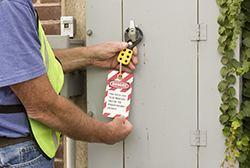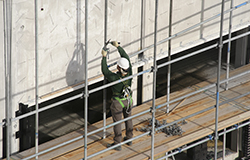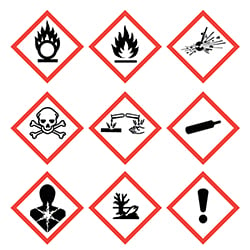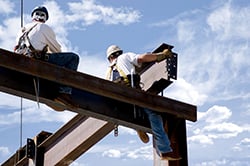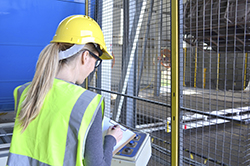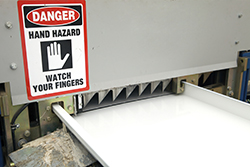Lockout/tagout (LOTO) is #5 on the list of most frequently cited OSHA standards with 2,704 violations. OSHA estimates that compliance with the standard could prevent 500,000 injuries and 120 fatalities a year. What can your company do to meet this standard and properly protect your workforce from the dangers of hazardous energy during the machine inspection and maintenance process?
4 min read
Controlling Hazardous Energy: Lockout/Tagout Safety
By Gibson on Apr 8, 2015 6:30:00 AM
Topics: Commercial Insurance Risk Management Workers' Compensation
3 min read
Scaffold Safety In Construction
By Gibson on Mar 23, 2015 6:30:00 AM
According to OSHA, approximately 2.3 million construction workers frequently work on scaffolds. Scaffold-related accidents cause about 4,500 injuries and 50 deaths every year. They also result in $90 million in lost workdays. Taking steps to ensure compliance with the scaffolding standards could help employers protect workers and prevent significant costs.
Topics: Commercial Insurance Risk Management Construction Workers' Compensation
3 min read
Hazard Communication: The Right To Know
By Gibson on Feb 23, 2015 6:30:00 AM
Exposure to hazardous chemicals is a serious threat to workers. Employees have the right to know what chemicals are being used, their hazards, and how to safely handle them. OSHA’s Hazard Communication Standard is intended to “improve the quality and consistency of hazard information, making it safer for workers to do their jobs and easier for employers to stay competitive,” as described by former U.S. Secretary of Labor Hilda Solis.
Topics: Commercial Insurance Risk Management Health Risk Management Workers' Compensation
3 min read
The Essential Elements Of Fall Protection For Construction
By Gibson on Feb 4, 2015 6:30:00 AM
Fall protection for the construction industry has topped the OSHA list of most frequently cited standards year after year. In fact, falls are the leading cause of death in the construction industry with 294 of the 796 fatalities in 2013 being attributed to falls. Yet these fatalities can be prevented. What can you do to protect your employees from fall hazards?
Topics: Commercial Insurance Risk Management Construction Workers' Compensation
7 min read
2015 Marketplace Outlook
By Gibson on Jan 19, 2015 6:30:00 AM
Where is today’s property & casualty market and where is it headed in 2015? According to the Insurance Service Office’s (ISO) industry 6-month 2014 results:
- Insurer net written premium growth slowed to 4% from 4.3% in the first-half of 2013.
- Commercial lines insurers’ combined ratio rose 1.8 percentage points in the first-half of 2014 to 95.4%.
- Policyholder surplus rose 9.5% in first-half 2014 keeping it at record levels.
What does this mean in 2015 and what can insurance consumers expect from the marketplace?
Topics: Commercial Insurance Risk Management Workers' Compensation
2 min read
Finding The Right Fit: Personal Protective Equipment for Women
By Gibson on Dec 29, 2014 6:30:00 AM
Ill-fitting personal protecetive equipment (PPE) endangers your workers. Are you helping your employees find the right fit?
If PPE does not fit properly, it does not function as it should. It can therefore expose workers to health and safety risks. It can also negatively impact a worker’s ability to efficiently perform their job. If a worker’s gloves are too big they may put them at risk to getting a glove stuck in machinery or perhaps the loss of dexterity will prevent them from doing their job as well. Likewise, if their hard hat is constantly falling off as they look up, that not only endangers the worker’s head but slows them down as they keep putting the hat back on or use one hand to hold it.
Topics: Commercial Insurance Risk Management Construction Claims Workers' Compensation
2 min read
Understanding Mechanical Hazards
By Gibson on Nov 10, 2014 6:30:00 AM
Machines can significantly improve production and efficiency. But they do not come without risks. The moving parts, sharp edges, and hot surfaces are hazards to workers. Many machine-related injuries can be prevented with the proper use of safeguards. It is important to understand what dangers machines present and what elements are needed to implement effective safeguarding practices.
Topics: Commercial Insurance Risk Management Claims Workers' Compensation
3 min read
Culture As An Emerging Risk
By Gibson on Oct 7, 2014 8:40:00 AM
Employee Engagement. Company Culture. Establishing a positive company culture matters. A company’s culture can be an incredible asset…but if not given the proper attention, it can become your greatest risk.
Culture is the values, beliefs, and the norms of a company. It’s not your policies and procedures; it’s the way you do things. It has many facets. Safety, employee wellness, employee wellbeing, and even the overall organizational health. And in order to establish a positive culture, you must engage your company leaders AND your employees.
Topics: Commercial Insurance Risk Management ESOP Executive Construction Claims Employee Benefits Health Risk Management Personal Insurance & Risk Management Workers' Compensation
3 min read
Getting A Grip On Hand Protection
By Gibson on Sep 24, 2014 6:30:00 AM
According to the U.S. Bureau of Labor Statistics, approximately 250,000 serious injuries occur each year to hands, fingers, and wrists. About 8,000 of these result in amputations. A worker’s hands are so incredibly critical not only to their career, but also their personal lives. Action can be taken to help minimize the hazards to hands, especially through the use of equipment safety mechanisms, personal protective equipment (PPE), and proper training.
Topics: Commercial Insurance Risk Management Construction Claims Health Risk Management Workers' Compensation
4 min read
Safety Culture: Setting Your Sights At Zero
By Art Jacobs on Sep 19, 2014 6:30:00 AM
What Is The Mark Of A Proactive Safety Culture?
Early in my career I spent time working in manufacturing as a safety director. After an injury occurred, we would complete the accident investigation and root cause analysis. We figured out what happened, when it happened, why it happened, and how it happened. From there we determined how to keep the injury from occurring again. But why weren’t we doing this before the injury? Why weren’t we doing inspections, reviews, and managing processes BEFORE an injury to prevent it? Why were we waiting until an injury occurred?


